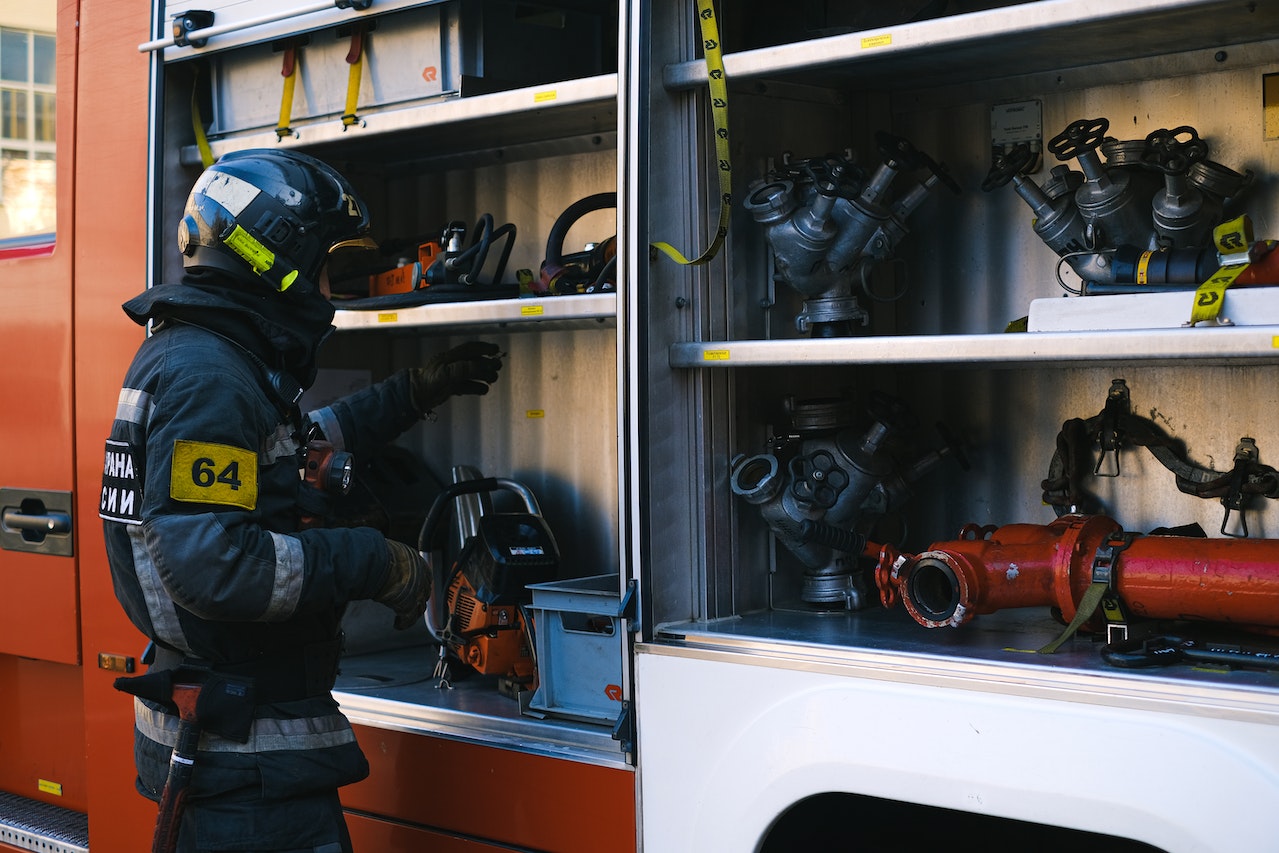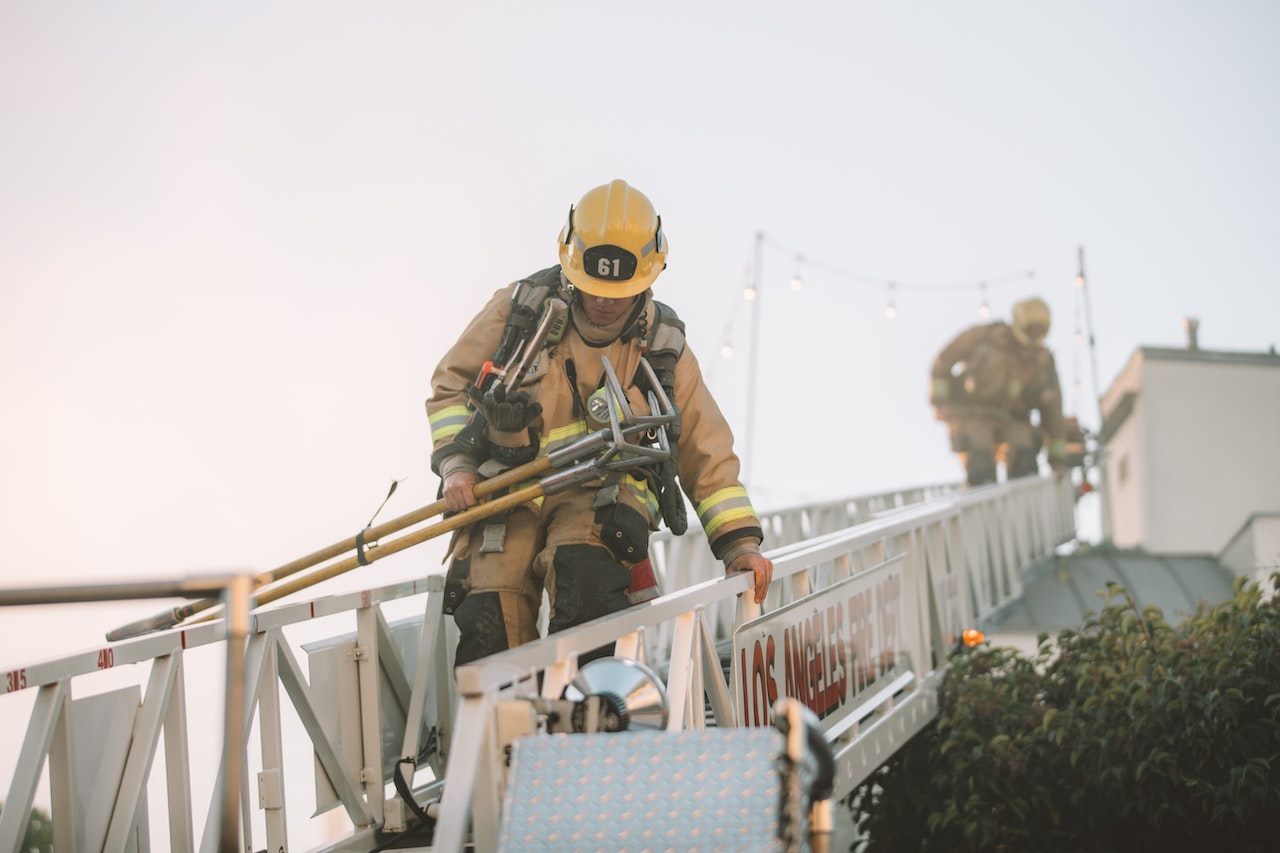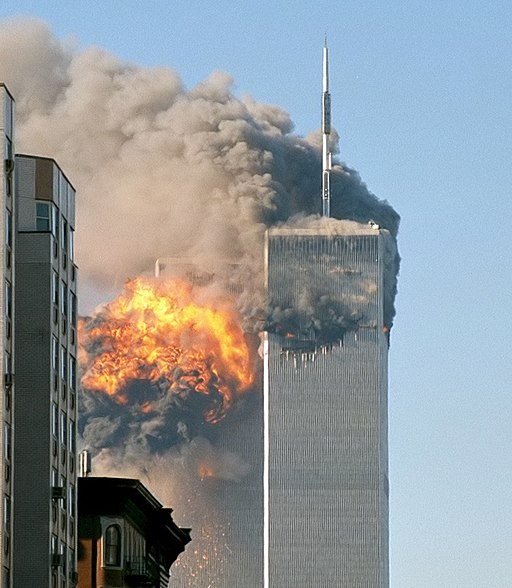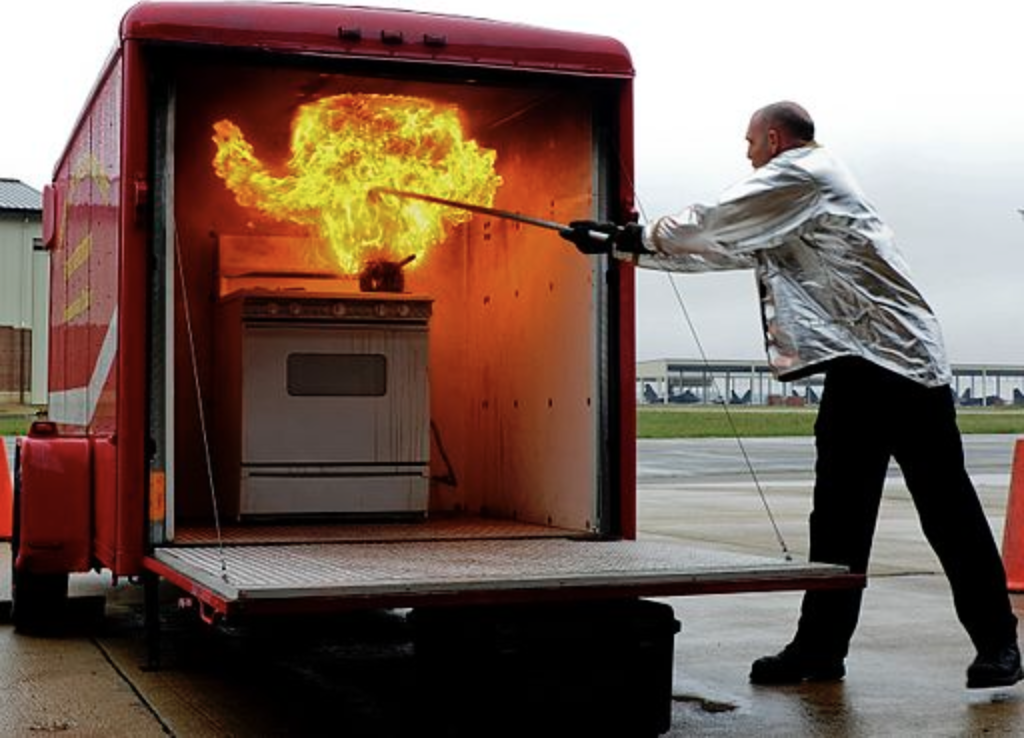Did you know that, in the United States, firefighters respond to a fire every 23 seconds? That’s over 1.3 million fires per year. But how do firefighters know how to extinguish the flames and keep us safe? It all starts with understanding the fire triangle and the different types of fires they may encounter.
This article will provide an in-depth look at firefighting, including the different classifications of fire, the tools and equipment used by firefighters, and the challenges and considerations specific to fighting fires in different types of structures and situations.
Before firefighters can put out a fire, they need to understand how it started. There are different things that can cause a fire to start and spread. Let’s learn more about these factors.

Ready for action: A firefighter stands ready with fire engine equipment at the ready.
How do fires start?
The fire triangle is a fundamental concept in firefighting that involves the three elements necessary for a fire to exist: oxygen, fuel, and heat. When the three elements come together, a chemical reaction occurs. This reaction releases energy in the form of heat and light, which is known as a fire. Firefighters must remove one or more elements from the equation to extinguish a fire.
Understanding the fire triangle is crucial for firefighters as it helps them identify the source of a fire and determine the most effective method for extinguishing it. For example, if a flammable liquid fuels a fire, firefighters may use a foam agent to remove the fuel element from the equation. Alternatively, firefighters may use water to remove the heating element and cool down the fire if a solid material, such as wood or paper, fuels the fire.
Now that we’ve covered the basics of firefighting and the importance of the fire triangle, let’s delve deeper into the classifications of fires.
Classifications of Fire
In firefighting, it’s important to understand the different types of fires based on the materials that are burning. There are four main classes of fire:
- Class A fires include common combustibles, such as wood, paper, and fabric. Water is usually the most effective extinguishing agent for Class A fires.
- Class B fires involve flammable liquids, such as gasoline, oil, and paint. Foam or dry chemical agents are typically used to extinguish Class B fires.
- Class C fires include electrical equipment, such as appliances, wiring, and circuit breakers. Non-conductive extinguishing agents, like CO2 or dry chemicals, are used to extinguish Class C fires.
- Class D fires involve combustible metals, such as magnesium, aluminum, and potassium. Specialized dry powder agents are used to extinguish Class D fires.
- Class K fires include cooking oils and fats, such as vegetable oil and lard. Water-based extinguishing agents, such as wet chemical agents or foam, are typically used to extinguish Class K fires.

A firefighter carefully makes their way down a ladder with equipment in hand.
Tools and Equipment
Some of the most common tools and equipment used by firefighters include:
- Fire hoses: Fire hoses are used to deliver water to the fire to extinguish it. Fire hoses come in various sizes and types, depending on the situation’s needs.
- Ladders: Ladders are used to access upper floors or roofs of buildings and rescue people from high places. Firefighters use various ladders, including extension ladders, aerial ladders, and ground ladders.
- Breathing apparatus: Firefighters use breathing apparatus to protect themselves from a fire’s smoke and toxic gases. There are various types of breathing apparatus, including self-contained breathing apparatus (SCBA) and supplied air respirators (SAR).
- Other tools and equipment: Firefighters also use other tools and equipment, such as fire extinguishers, hand tools, thermal imaging cameras, and hydraulic rescue tools.
Firefighting in different fire situations
How do firefighters put out fires in skyscrapers?
Firefighters have to take a different approach when fighting fires in skyscrapers compared to other types of structures. One of the key challenges in fighting fires in skyscrapers is the height of the building. This can hinder firefighters’ ability to access the fire and effectively put it out.
If the fire is on a lower floor and can be accessed using aerial appliances, such as ladders or aerial platforms, firefighters may use these to attack the fire directly.
If the fire is on an upper floor or is too intense to be fought directly, firefighters may take a defensive approach, focusing on containing the fire and preventing it from spreading to other parts of the building. This may involve using water from a fire hose to cool down the fire and prevent it from spreading, as well as using other tactics, such as ventilation, to remove the heat and smoke from the building.

Robert on Flickr, CC BY-SA 2.0, via Wikimedia Commons
Modern high-rise buildings often have firefighting systems, such as sprinkler systems, that can help control and extinguish fires. These systems can effectively contain fires and prevent them from spreading, but they may not fully extinguish a fire if it is too large or intense. In these cases, a fire service may need to intervene and use additional tactics and techniques to control the fire.
The September 11th attacks on the World Trade Center in New York City demonstrated the challenges and complexities of fighting fires in skyscrapers. The fires that resulted from the attacks were intense and spread quickly. The collapse of the towers made it challenging for firefighters to access and extinguish the flames.
Despite facing those challenges, the firefighters demonstrated incredible bravery and dedication as they worked tirelessly to save lives, which is their top priority.
How do firefighters put out electrical fires?
According to data from the California Department of Forestry and Fire Protection (CDFFP), electrical fires accounted for 76% of all fires recorded between 2000 and 2020.
An electrical fire is a type of fire that involves electrical equipment or wiring. Several factors can contribute to the start of an electrical fire, such as faulty wirings or outlets, overloaded circuits, and malfunctioning or outdated appliances.
One of the key challenges in fighting electrical fires is that water, typically the most effective extinguishing agent for other types of fires, is not safe to use on electrical fires. Water is a conductor of electricity and can cause serious injury or death if used in this case. It can also cause damage to the electrical equipment or wiring, which can lead to further fires.
To extinguish an electrical fire, firefighters must use a non-conductive extinguishing agent that will not cause harm to people or damage to the electrical equipment. Some of the most commonly used extinguishing agents for electrical fires include CO2, dry chemical agents, and foam.
How do firefighters put out forest or wildland fires?
There are several methods that firefighters may use to extinguish wildland or forest fires:
- Direct attack:
This involves using hand tools such as shovels, rakes, and Pulaskis to dig a line around the fire’s perimeter, creating a barrier that the fire cannot cross. Firefighters may also use hoses to apply water directly to the fire.
2. Indirect attack:
This involves attacking the fire from a distance, using tactics such as controlled burning, which is deliberately setting a smaller fire for burning fuel in the path of the main fire.
3. Fire suppression:
Firefighters may use firefighting foam. These chemicals create a barrier between the fuel and the fire, reducing the amount of oxygen available to the fire and helping extinguish it.
4. Cooling:
Firefighters may use water or other cooling agents to reduce the temperature of the fire, making it easier to extinguish.
5. Smothering:
In some cases, firefighters may cover the fire with a layer of dirt, sand, or other material to deprive it of oxygen and help extinguish it.
The specific tactics and techniques used to fight a wildland or forest fire will depend on the size, intensity, and location of the fire, as well as the availability of resources and the conditions on the ground.
How do you put out a grease fire?
Dealing with a grease fire is different than other fires. Grease fires are caused by the ignition of cooking oils or fats, which can burn quickly and intensely. Because of this, it is unsafe to use water or other liquid to extinguish a grease fire, as this can cause the flames to spread or the hot grease to splatter and ignite other materials.

Christian Jacobs, a fire inspector, demonstrates techniques for extinguishing a grease fire during Fire Prevention Week.
Here are some dos and don’ts for putting out a grease fire:
DOs:
- Stay calm and call the fire department or fire station immediately.
- Turn off the heat source if it is safe to do so.
- If the fire is small and contained to a pan, use a lid or baking soda to smother the flames.
- If the fire is larger, use a fire extinguisher designed for grease fires.
DON’Ts:
- Do not try to carry the burning pan outside or pour water on the fire. That can spread the flames or cause the grease to splatter and ignite other materials.
- Do not use flour or other dry substances to extinguish the fire. These can make the fire worse.
- Do not use a foam fire extinguisher on a grease fire. Foam extinguishers are ineffective at extinguishing grease fires and can cause the fire to spread.
Firefighters receive training in comprehending the fire triangle and the classifications of fires. They also receive training in the tools and equipment required to control and put fires out. They must also prepare to confront the challenges and considerations specific to fighting fires in various structures and circumstances.
Regardless of the size of the fire, be it a small kitchen fire or a large building in flames, firefighters undergo training in the application of specialized tactics and techniques to control and extinguish it. From understanding the factors that contribute to the start and spread of fires to using specialized equipment and tactics to extinguish them, firefighters are essential in protecting communities from the dangers of fire.


